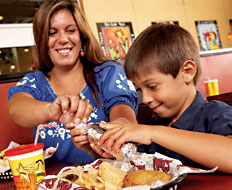It’s no secret that there’s been a push from consumers for healthier options at quick-service restaurants. But what’s harder to determine is what kind of effect a healthy roll out will have on operators’ food budgets.
As restaurants shift toward healthier menus, operators will “need to see the lift in sales in order to pay out the additional costs of goods on the sourcing of better products,” says Jonathan Marek, senior vice president of Applied Predictive Technologies, which helps companies predict expenses and profitability of new initiatives. “Everything has cost implications, but it’s primarily about the demand side.”
This means, Marek says, that customer behavior will be an overriding factor in the industry’s move toward better nutrition.
“Do [healthier items] create a health halo, or cannibalize other products on the menu?” he says. “Whenever you put a new product out there, it’s taking away from something else on the menu. Either it’s something you drop, or likely it’s something that’s still there, where it’s shifting demand.”
Some operators see menu changes as a marketing expense. “If you get a 3 percent traffic count, or check-count increase, that’s a huge number,” Marek says. “If you can get that in the door—either by products that people want and they come back again and again, or just by marketing that positions yourself as increasingly healthy—that gets people to consider your brand in a different way and come more often.”
If an operator increases the cost of goods without upping traffic, Marek says, it will be hard to be profitable without cutting back on labor or other large costs.
National quick-serve companies heavily depend on efficient supply chains, says Aaron Allen, founder and CEO of Quantified Marketing Group. He says efficiencies in factory-scaled food production create an average 18-month period between developing a menu change and rolling it out to stores. “[We move] at a much slower pace than what the consumer now expects and demands,” Allen says.
But public attitudes are rapidly changing, influenced by activist groups, media attention, and even government actions. All of these trends, combined with a movement toward “culinary adventures and authenticity in ethnic foods, is reshaping menus very quickly,” Allen says.
“The economies of these large-scale restaurants and feedlots and other things that we’ve been able to do with modern agriculture have helped pull costs down,” Allen says. “I think we will start to warm up to the idea that it costs more for us to be healthy on a per-meal basis.”
Allen sees rapid shifts in consumer dining behaviors “forcing us as an industry to look much more closely at supply chains as a competitive advantage.”
“If [quick serves] can figure out how to get fresh food affordably to a consumer and still make it as convenient as they have, which they’ve [historically] done so well, it’s a huge win for them,” he says. “But how do you do that without alienating that core audience?”
This is the debate that is happening at large quick-serve companies, Allen says, and the fuel that is driving emerging brands that see opportunity in the new customer demand.
Ed Frechette is senior vice president of marketing for Au Bon Pain, one of the brands taking advantage of customers’ newfound willingness to splurge on healthier items. “We tend to charge more than an [average quick serve] for the sandwiches and salads that we have, but we believe the price value is better, because the quality is better,” he says.
Further, about 15 percent of Au Bon Pain customers use in-store kiosks to review nutritional information, Frechette says. This shows that restaurants are justified in their investment in health and nutrition, he says.
Lloyd M. Gordon, founder and president of GEC Consultants, says operators should weigh the financial aspects of shifting to healthier menus before they do so.
“We’re getting a lot of hype about what’s healthy and what isn’t healthy,” Gordon says. “That hype is likely to be undermined in a very short time, and you’ll be left holding the bag, with an expensive program that has been demystified.”
But if it’s a turnaround situation where sales are lagging, Gordon says, a menu change to healthier fare may increase a quick serve’s profitability.
“In some cases, the restaurant industry can just reduce the amount of certain ingredients, and chances are the customers will not even notice—cutting back 10 percent on cheese, or oil, for example,” says Erica Bohm, vice president and director of strategic partnerships for Healthy Dining, a company that identifies healthy restaurants.
Dan Barash, executive chef of Moe’s Southwest Grill, says he and his colleagues are aware that customers don’t necessarily visit Moe’s to have a healthy meal. But that hasn’t stopped the company from investing in nutrition where it makes sense.
“We wanted to make sure that we kept the quality of the ingredients and the flavor profile where it was,” he says. Still, in two years, Moe’s cut salt 50 percent across the menuboard.
“Now we’re guaranteeing that our [steak] is 100 percent grass fed, with no added hormones,” he says. “All of our salsas now are made with all-natural ingredients.”
The industry’s buying power also works to its advantage, Barash says. “The more that we as a group come out and talk about this with our suppliers, the more they go out and talk to their suppliers and the more they go out to the growers and this stuff becomes more available and less expensive.”













